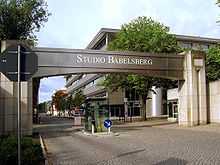Babelsberg Studio
The Babelsberg Film Studio (German: Filmstudio Babelsberg, FWB: BG1), located in Potsdam-Babelsberg next to Berlin, Germany, is the oldest large-scale film studio in the world, producing films since 1912. Today it covers an area of about 25,000 square metres (270,000 sq ft) and thus is Europe's largest film studio.[1]
Hundreds of films, including Fritz Lang's Metropolis and Josef von Sternberg's The Blue Angel were filmed there. More recent productions include V for Vendetta, The Bourne Ultimatum, Valkyrie, Inglourious Basterds and Cloud Atlas.
Today, Studio Babelsberg remains operational mainly for feature film productions. Furthermore, it acts as co-producer on international high budget productions.
History


In 1911, the company Bioscop built its first glass–film studio in Neubabelsberg. The first filming began as early as February 1912 for The Dance of the Dead by Danish director Urban Gad. In 1920 the Deutsche Bioscop Gesellschaft merged with Erich Pommer's Decla-Film GmbH into „Decla Bioscop“. In 1921, Decla-Bioscop merged with Universum Film AG (Ufa) which had been founded in 1917. This company built the large studio (which is now known as the "Marlene Dietrich Halle") in 1926 for the major film production of Metropolis by Fritz Lang. The first German sound stage in Babelsberg, the Tonkreuz, was built during 1929. Melodie des Herzens/Melody of the Heart with Willy Fritsch was the first German full-sound film. This was followed in 1930 by the premiere of The Blue Angel by Josef von Sternberg with Marlene Dietrich and Emil Jannings in the main roles.
From 1933 to 1945, around 1,000 feature films were made in the studios and on the studio lot. Under the direction of Hitler's propaganda chief Joseph Goebbels, the studio churned out hundreds of films including Leni Riefenstahl's openly propagandistic Triumph of the Will. The virulently anti-Semitic propaganda film Jud Süss (The Jew Süss), shot in 1940, was also made at Babelsberg.[2]
On May 17, 1946, the DEFA - Deutsche Film AG - was established. It produced over 800 feature films, including 150 children's films. In addition, over 600 films were made for television from 1959 to 1990. The DEFA period was honored by a retrospective at the Museum of Modern Art (MOMA) in New York in 2005.
After the fall of the Berlin Wall, the Treuhand took over the responsibility for the privatisation of the former DEFA. In August 1992, the Treuhandanstalt sold the former DEFA film studios in Babelsberg to the French group Compagnie Générale des Eaux (later absorbed into Vivendi Universal). Over the following 12 years the company invested around €500 million updating the studio's infrastructure.
In July 2004, Vivendi sold Studio Babelsberg to the investment company FBB (Filmbetriebe Berlin Brandenburg GmbH), which has Carl Woebcken and Christoph Fisser as shareholders. In Spring of 2005, the restructured studio presented an initial public offering and began trading on the free market.
2007 was the most profitable year since the Studio's privatization in 1992 - 12 feature films were shot at Studio Babelsberg, among them Valkyrie with Tom Cruise, The International with Clive Owen, and The Reader with Kate Winslet.
In 2008 Studio Babelsberg and Hollywood producer Joel Silver formed a strategic alliance to produce feature films from the Dark Castle production slate at the world’s oldest film studio.
Recent co-productions of Studio Babelsberg include Quentin Tarantino's Inglourious Basterds (released 2009), Roman Polanski's The Ghost Writer (2010) and Brian De Palma's Passion (2012).
Notable films shot at Babelsberg Studios


- Das Cabinet des Dr. Caligari (1920)
- Der müde Tod (1921)
- Dr. Mabuse, der Spieler (1922)
- Die Nibelungen (1924)
- Metropolis (1927)
- Spione (1928)
- Frau im Mond (1929)
- Der blaue Engel (1930)
- La Habanera (1937)
- Jud Süß (1940)
- Das Beil von Wandsbek (1951)
- Die Geschichte vom kleinen Muck (1953)
- Das singende, klingende Bäumchen (1957)
- Sonnensucher (1958)
- Sterne (1959)
- Karbid und Sauerampfer (1963)
- Nackt unter Wölfen (1963)
- Der geteilte Himmel (1964)
- Die Abenteuer des Werner Holt (1965)
- Spur der Steine (1966)
- Ich war neunzehn (1968)
- Goya – oder der arge Weg der Erkenntnis (1971)
- Die Legende von Paul und Paula (1973)
- Jakob der Lügner (1974)
- Sieben Sommersprossen (1978)
- Solo Sunny (1980)
- Der Aufenthalt (1983)
- Sonnenallee (1999)
- The Pianist (2002)
- Around the World in 80 Days (2004)
- Kingdom of Heaven (2004)
- The Bourne Supremacy (2004)
- The Constant Gardener (2005)
- Flightplan (2005)
- Zwartboek (2006)
- V for Vendetta (2006)
- The Bourne Ultimatum (2007)
- Die Fälscher (2007)
- Valkyrie (2008)
- Speed Racer (2008)
- The Reader (2008)
- Flammen & Citronen (2008)
- The International (2008)
- Inglourious Basterds (2009)
- Ninja Assassin (2009)
- Pandorum (2009)
- The Ghost Writer (2010)
- Hanna (2011)
- Anonymous (2011)
- Poulet aux prunes (2011)
- Passion (2012)
- Cloud Atlas (2012)
- G.I. Joe: Retaliation (2012)
- Hansel & Gretel: Witch Hunters (2013)
- The Book Thief (2013)
- La Belle et la Bête (2014)
- The Grand Budapest Hotel (2014)
- The Monuments Men (2014)
- The Voices (TBA)
See also: Category:Babelsberg Studio films
Bibliography
- Hans-Jürgen Tast (ed.) ANTON WEBER (1904–1979) - Filmarchitekt bei der UFA (Schellerten 2005) ISBN 3-88842-030-X;
References
- ↑ Studio Babelsberg - Mit der Erschließung des direkt in der Nachbarschaft befindlichen Filmgeländes mit den Studios Neue Film 1 und Neue Film 2 konnte Studio Babelsberg seine Studiokapazitäten verdoppeln und verfügt so über Europas größten zusammenhängenden Studiokomplex., retrieved 3 December 2013 (German)
- ↑ Spiegel, 09/06/07
External links
| Wikimedia Commons has media related to Babelsberg Studios. |
Coordinates: 52°23′13″N 13°07′10″E / 52.38694°N 13.11944°E